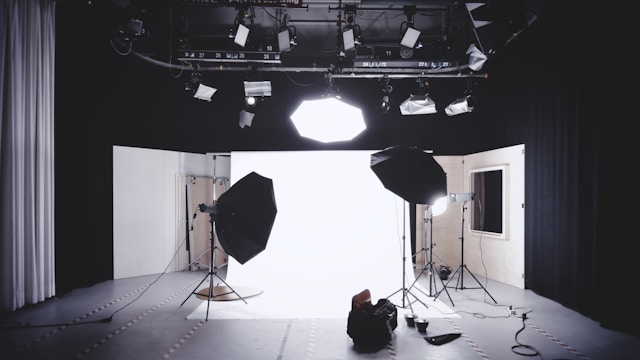Mastering the Art of Lighting: Tips for Professional Video Podcast Shoots

 Jan 26, 2025
Jan 26, 2025
 Podcast
Podcast
Mastering the Art of Lighting: Tips for Professional Video Podcast Shoots
In today’s digital age, nothing beats the power of video content. Sets, costumes and equipment all impact viewers. However, one factor often neglected in podcast production is lighting.
In this blog, we'll discuss essential tips for achieving perfect lighting for video podcast shoots, regardless of your budget or space constraints.
Proper Lighting Explained
In this blog, we'll discuss essential tips for achieving perfect lighting for video podcast shoots, regardless of your budget or space constraints.
Enhances Visual Quality: Proper lighting allows both you and your surroundings to be illuminated vividly and recorded accurately.
Enhancing viewer experience: Lighting is essential for providing an enjoyable viewing experience, helping audiences remain engaged with and focused on your content.
Brand Enhancement: Producing an engaging podcast video can greatly strengthen your brand reputation.
Flexibility and Creativity: With creative lighting, you can add depth and dimension to your content.
Lighting Systems Commonly Employed in Video Podcasts
Key Light: It is always the main light source and most influential when setting a scene.
Fill Light: Fill lighting can help soften and balance key lighting sources to decrease shadows and contrast.
Backlight: Backlighting provides depth and dimension when used to differentiate subjects from backgrounds, giving greater depth to the subjects being illuminated.
Ring Light: For evenly and diffusely illuminated close-up shots, this lighting tool offers particularly flattering illumination.
Lighting Setups Used In Creating Video Podcasts
Three-point lighting utilizes three lights at specific angles: a key light on one side of the camera, a fill light on the other, and a backlight behind your subject to produce an even and professional appearance.
A two-light setup uses just the key and fill lights but is often supplemented with a natural light source or a bounce card (a reflective surface that redirects light) which gives the set a more natural, less stylized look.
A four-light setup adds another layer to the three-point video lighting — a background light that illuminates the background and enhances the context of your scene.
Loop lighting involves two lights - a key light and a backlight. This setup is often employed in video productions that showcase a person's features, create portraits, or create talking-head videos.
One-light uses a ring light that produces even, flattering illumination, which is optimal for scenarios where subjects directly address the camera or when simplicity and speed are essential components of success.
LEDs offer exceptional flexibility with adjustable color temperatures* and brightness settings. They are portable enough for key lighting and fill lighting applications.
Color temperature helps create the atmosphere and professionalism of your podcast by giving it the desired look. Measured in Kelvin (K), it can be divided into two distinct categories: warm and cool. Warmer hues provide cozy comfort, while cooler ones convey professionalism or seriousness.
Rules To Follow For Proper Lighting
Rule 1: Choose a controlled environment
Producing videos in an environment you can control, such as professional studio lighting or a quiet room, allows you to control light.
Rule 2: Clean your set
A tidy environment looks better on camera and reduces unwanted shadows and reflections. Before filming, declutter, clean, and organize your set.
Rule 3: Use consistent color temperature
Check and match color temperature ratings to get a consistent look throughout the shooting.
Rule 4: Avoid glare on glasses
If you are using glasses or glass cups, position your lights at angles that don't reflect the reflections of your set and equipment.
Rule 5: Use natural lighting
Even without access to studio lighting, natural lighting may still provide enough illumination.
Rule 6: Experiment with angles and positions
Experiment with different lighting angles and positions and find what works for you.
Rule 7: Use at least one LED light
LED lights offer you easy control of their intensity and movement, creating new lighting setups.
Lighting is not simply technical; it is an art form used to tell stories in video podcasts. Mastering this craft can enhance the quality of your videos while adding professional polish.
